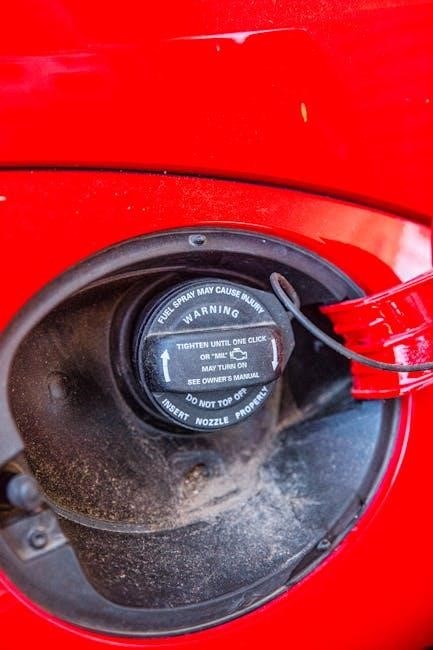Hyper Tough Code Reader Manual: A Comprehensive Guide
Welcome to your comprehensive guide to navigating the world of Hyper Tough code readers! This manual aims to provide clear instructions and helpful information for users of Hyper Tough OBD2 scanners․ Unlock the secrets to diagnosing your vehicle’s health!
Hyper Tough code readers offer an accessible entry point into the world of automotive diagnostics․ Designed for ease of use and affordability, these devices empower vehicle owners to understand and address common issues indicated by the check engine light․ By connecting to your vehicle’s OBD2 port, a Hyper Tough code reader can retrieve diagnostic trouble codes (DTCs), providing valuable insights into potential problems․
This guide serves as a comprehensive resource for understanding and utilizing Hyper Tough code readers effectively․ Whether you’re a seasoned DIY enthusiast or a first-time user, this manual will walk you through the basics of OBD2 technology, the features of various Hyper Tough models, and the steps involved in diagnosing and resolving vehicle issues․
With the help of a Hyper Tough code reader and this manual, you can save time and money by identifying problems early and making informed decisions about vehicle repairs․ From accessing product manuals via QR codes to interpreting error codes and utilizing companion apps, we’ll cover everything you need to know to confidently use your Hyper Tough code reader․
Understanding OBD2 and Code Readers
OBD2, or On-Board Diagnostics II, is a standardized system used in most vehicles manufactured since 1996 to monitor engine performance and emissions․ This system allows mechanics and vehicle owners to access information about the vehicle’s health, identify potential problems, and ensure compliance with emissions standards․
Code readers are essential tools for accessing the data provided by the OBD2 system․ They connect to the vehicle’s diagnostic port, typically located under the dashboard, and retrieve diagnostic trouble codes (DTCs) stored by the vehicle’s computer․ These codes are alphanumeric identifiers that correspond to specific issues or malfunctions detected by the system․
Understanding the basics of OBD2 and code readers is crucial for effectively diagnosing and resolving vehicle problems․ By learning how to interpret DTCs and utilize code reader features, you can gain valuable insights into your vehicle’s performance and make informed decisions about repairs․ This section provides a foundation for using Hyper Tough code readers to troubleshoot common automotive issues․
Furthermore, knowing the capabilities and limitations of OBD2 systems empowers users to maintain their vehicles proactively․

Hyper Tough HT100 Code Reader: Overview
The Hyper Tough HT100 code reader is a user-friendly device designed to help you diagnose and troubleshoot issues with your vehicle․ Compatible with most 1996 and newer OBD2 vehicles, the HT100 provides access to essential diagnostic information, empowering you to understand your car’s health․
This code reader is equipped with a simple interface, making it easy to read and interpret diagnostic trouble codes (DTCs)․ It also offers free fix and part recommendations through the RepairSolutions2 app, streamlining the repair process․ By pairing the HT100 with the app, you can access a comprehensive automotive repair database with verified fixes from ASE Master Technicians․
The HT100’s key features include its ability to read and clear DTCs, view freeze frame data, and perform I/M readiness tests․ Its compact design and ease of use make it a valuable tool for both novice and experienced car owners․ Furthermore, the HT100 helps you identify the right fix and get the right parts, saving you time and money on car repairs․
To access the HT100 product manual, simply scan the QR code provided․
Accessing the HT100 Product Manual via QR Code
Gaining access to the Hyper Tough HT100 code reader’s product manual is straightforward, thanks to the inclusion of a QR code․ This convenient method allows users to quickly retrieve the manual using their smartphones or tablets, ensuring they have all the necessary information at their fingertips․
To access the manual, simply locate the QR code, which is typically found on the product packaging, the device itself, or in accompanying documentation․ Open the camera app on your smartphone or tablet and ensure it has QR code scanning capabilities․ Point the camera at the QR code, and your device should automatically detect and scan it․
Once scanned, the QR code will redirect you to a webpage or a downloadable PDF file containing the complete HT100 product manual․ The manual provides detailed instructions on how to use the code reader, interpret error codes, and troubleshoot common issues․ It also includes important safety information and warranty details․
If your device does not automatically scan the QR code, you may need to download a dedicated QR code scanner app from your app store․ These apps are readily available and easy to use․
Hyper Tough HT300 Code Reader: Overview

The Hyper Tough HT300 code reader is a user-friendly tool designed for diagnosing vehicle issues and reading diagnostic trouble codes (DTCs)․ It’s compatible with all 1996 and newer OBD2 vehicles, making it a versatile option for both DIY enthusiasts and professional mechanics․ The HT300 allows users to quickly identify the cause of a check engine light, saving time and money on potential repairs․
This code reader features a clear LCD display that shows DTCs and their descriptions, providing immediate insight into the problem․ Its simple interface and intuitive buttons make navigation easy, even for those with limited experience․ The HT300 also supports multiple languages, catering to a diverse range of users․
Beyond reading codes, the HT300 can also clear DTCs and reset the check engine light․ This feature is useful after repairs have been made to ensure the issue is resolved․ The reader is powered directly by the vehicle’s OBD2 port, eliminating the need for batteries․
The HT300 often comes with access to the RepairSolutions2 app, offering further diagnostic support and repair recommendations;

Hyper Tough HT309 OBD2 Code Reader: Overview
The Hyper Tough HT309 OBD2 code reader is a compact and user-friendly device designed to diagnose check engine light issues in OBD2 compliant vehicles (1996 and newer)․ This tool offers a simple and efficient way to retrieve diagnostic trouble codes (DTCs), providing valuable information about potential problems with your vehicle’s engine and related systems․ Its ease of use makes it suitable for both novice and experienced users․
The HT309 features a straightforward interface with dedicated buttons for common functions, such as reading and erasing codes․ The built-in screen displays the retrieved DTCs and their descriptions, helping you understand the nature of the issue․ It also supports retrieving generic and manufacturer-specific codes, offering a comprehensive diagnostic capability․

This code reader connects directly to your vehicle’s OBD2 port and is powered by the vehicle, eliminating the need for batteries․ Some models also include access to the RepairSolutions2 app, which provides additional information, repair suggestions, and parts recommendations based on the retrieved codes․
The HT309 is a valuable tool for identifying the cause of a check engine light and making informed decisions about vehicle repairs․
Using the Hyper Tough HT309 Code Reader
Using the Hyper Tough HT309 code reader is a straightforward process․ First, locate the OBD2 port in your vehicle, which is typically found under the dashboard on the driver’s side․ Ensure your vehicle is turned off before plugging the HT309 into the OBD2 port․ Once connected, turn the ignition to the “on” position, but do not start the engine․

The HT309 will power on and display the main menu․ Use the navigation buttons to select the “Read Codes” option․ The device will then scan your vehicle’s computer for any stored diagnostic trouble codes (DTCs)․ After the scan is complete, the HT309 will display the DTCs along with a brief description of each code․
To erase the codes after addressing the underlying issue, select the “Erase Codes” option from the main menu․ Keep in mind that erasing codes will also reset the vehicle’s readiness monitors․ It is important to allow the vehicle to complete its drive cycles to ensure all systems are functioning correctly after clearing the codes․ Always consult your vehicle’s service manual for specific diagnostic and repair procedures․

The HT309 simplifies the process of understanding and addressing check engine light issues․
Interpreting Error Codes
Interpreting error codes, also known as Diagnostic Trouble Codes (DTCs), is crucial for understanding your vehicle’s issues․ These codes, retrieved by your Hyper Tough code reader, are alphanumeric identifiers that pinpoint specific problems within your car’s systems․ A typical DTC consists of five characters: a letter followed by four numbers․
The letter indicates the system affected: ‘P’ for powertrain, ‘B’ for body, ‘C’ for chassis, and ‘U’ for network communication․ The first number after the letter specifies whether the code is generic (standardized across manufacturers) or manufacturer-specific․ The remaining three numbers provide a more detailed description of the fault․

For instance, a code like P0300 indicates a random or multiple cylinder misfire in the engine․ It’s important to consult a reliable source, such as the RepairSolutions2 app or a comprehensive DTC database, to get a full understanding of the code’s meaning and potential causes․
While the code provides a starting point, further diagnosis may be required to accurately pinpoint the root cause of the problem․ Remember that simply replacing parts based solely on the DTC may not always resolve the issue․
Finding and Understanding DTCs (Diagnostic Trouble Codes)
Diagnostic Trouble Codes (DTCs) are at the heart of vehicle diagnostics, acting as pointers to potential problems within your car’s intricate systems․ Your Hyper Tough code reader is designed to retrieve these codes, but understanding them is key to effective troubleshooting․ The process starts by connecting your reader to your vehicle’s OBD2 port, typically located under the dashboard․
Once connected and powered on, the reader will communicate with the vehicle’s computer and display any stored DTCs․ These codes are usually presented as a series of alphanumeric characters, such as P0171 or C1234․ Each character holds specific information about the fault․
The first character signifies the system involved: Powertrain (P), Body (B), Chassis (C), or Network (U)․ The subsequent digits offer further details about the nature and location of the problem․ For example, a ‘P0’ code indicates a generic powertrain issue, while ‘P1’ might denote a manufacturer-specific powertrain fault․
To decipher the meaning of a DTC, consult your Hyper Tough code reader’s manual or utilize the RepairSolutions2 app, which offers a comprehensive database of DTC definitions and potential fixes verified by ASE Master Technicians․
Using the RepairSolutions2 App with Hyper Tough Readers
The RepairSolutions2 app significantly enhances the functionality of your Hyper Tough code reader, transforming it from a simple code retrieval tool into a comprehensive diagnostic and repair assistant․ This free app seamlessly pairs with your code reader, providing access to a vast database of automotive repair information․
To get started, download and install the RepairSolutions2 app on your smartphone or tablet․ Once installed, follow the app’s instructions to connect it to your Hyper Tough code reader, typically via Bluetooth or USB․ After the connection is established, the app can read the DTCs retrieved by your code reader․
The real power of RepairSolutions2 lies in its ability to interpret these codes and provide detailed information about the potential causes of the problem, along with verified fixes from ASE Master Technicians․ The app also offers part recommendations, helping you find the right components for the repair․
Furthermore, RepairSolutions2 can track your vehicle’s maintenance history, provide estimated repair costs, and even help you schedule appointments with local mechanics․ This integration streamlines the diagnostic and repair process, saving you time and money․
Connecting the Code Reader to Your Vehicle
Connecting your Hyper Tough code reader to your vehicle is a straightforward process that allows you to access valuable diagnostic information․ First, locate the OBD2 port in your vehicle․ This port is typically found under the dashboard on the driver’s side, but consult your vehicle’s owner’s manual for the exact location if you’re unsure․
Once you’ve located the OBD2 port, ensure that your vehicle’s ignition is turned off․ Plug the code reader’s connector firmly into the OBD2 port․ You should feel a click or slight resistance as it securely connects․
Next, turn the ignition key to the “on” position, but do not start the engine․ This provides power to the code reader, allowing it to communicate with your vehicle’s computer system․ The code reader’s display should light up, indicating that it is receiving power․
Follow the instructions in your Hyper Tough code reader’s manual to begin the diagnostic process․ Typically, you’ll need to select an option like “Read Codes” or “Diagnostic Scan” from the menu․ The code reader will then communicate with your vehicle’s computer and retrieve any stored Diagnostic Trouble Codes (DTCs)․
If you encounter any issues during this process, double-check the connection to the OBD2 port and ensure that the ignition is in the “on” position․
Navigating the User Interface
Understanding the user interface of your Hyper Tough code reader is crucial for effective vehicle diagnostics․ The interface typically consists of a display screen and several buttons that allow you to navigate menus and access different functions․ Familiarize yourself with the button layout and their corresponding actions by referring to the product manual․
The main menu usually presents options such as “Read Codes,” “Erase Codes,” “Live Data,” “I/M Readiness,” and “Vehicle Information․” Use the arrow buttons to scroll through these options and the “Enter” or “OK” button to select your desired function․
When reading codes, the display will show the Diagnostic Trouble Codes (DTCs) stored in your vehicle’s computer․ These codes are typically displayed with a code number (e․g․, P0123) and a brief description of the fault․ Use the arrow buttons to view additional details about each code, if available․

For features like “Live Data,” the display will show real-time information from your vehicle’s sensors, such as engine temperature, RPM, and O2 sensor readings․ Use the arrow buttons to scroll through the available data parameters․
Remember to consult your Hyper Tough code reader’s manual for specific instructions and explanations of all available functions and display elements․ Understanding the user interface will empower you to efficiently diagnose and address vehicle issues․

Clearing Codes and Understanding Readiness Monitors
Once you’ve addressed the issue indicated by a Diagnostic Trouble Code (DTC), you’ll likely want to clear the code from your vehicle’s computer․ The “Erase Codes” function on your Hyper Tough code reader allows you to do this․ However, it’s important to understand the implications before clearing codes․
Clearing codes not only removes the DTC from the vehicle’s memory, but it also resets the readiness monitors․ Readiness monitors are diagnostic tests that the vehicle’s computer performs to ensure that various systems, such as the catalytic converter and oxygen sensors, are functioning correctly․
After clearing codes, these monitors need to run again to confirm that the issue has been resolved․ This process can take several drive cycles, which involve driving the vehicle under specific conditions (e․g․, highway driving, city driving, idling)․ During this time, the check engine light may remain off, but the vehicle might not pass an emissions test until all readiness monitors are complete․
The “I/M Readiness” function on your code reader allows you to check the status of these monitors․ A “Ready” status indicates that the monitor has completed successfully, while a “Not Ready” status means that the monitor is still running․
Therefore, it’s crucial to understand the readiness monitor status before clearing codes, especially if you need to pass an emissions test․ Consult your vehicle’s repair manual for specific information on drive cycles and readiness monitor requirements․
Troubleshooting Common Issues
Even with a user-friendly device like a Hyper Tough code reader, you might encounter some common issues․ One frequent problem is the “Link Error,” which means the code reader cannot establish a connection with the vehicle’s computer․ Ensure the ignition is turned to the “ON” position (engine off) and the code reader is securely plugged into the OBD2 port․ Check your vehicle’s manual for the port location if you’re unsure․
Another issue arises when the code reader displays “No Codes Found,” even though the check engine light is illuminated․ This could indicate a pending code that hasn’t yet triggered the light, or it could signify a more complex issue that the code reader can’t detect․ Try scanning again after driving the vehicle for a while․
If you’re having trouble interpreting the error codes, double-check the code against a reliable database like RepairSolutions2․ Remember, the code provides a starting point, not a definitive diagnosis․ Further investigation might be required․
Sometimes, the code reader might freeze or display garbled text․ In such cases, try disconnecting and reconnecting the device․ If the problem persists, consult the Hyper Tough website for firmware updates or contact their customer support for assistance․ Ensure the reader is compatible with your vehicle year, make and model․
Lastly, always refer to your vehicle’s service manual for specific troubleshooting steps related to the detected error codes․ Remember safety precautions․
Where to Find Hyper Tough Manuals and Support
Accessing the correct manual and finding reliable support are crucial for maximizing the utility of your Hyper Tough code reader․ The primary location for obtaining your specific model’s manual is often through a QR code printed directly on the device or its packaging․ Scanning this code with your smartphone will typically direct you to a digital version of the manual․
If you’ve misplaced the packaging or the QR code is unreadable, the Hyper Tough website is another excellent resource․ Navigate to the “Support” or “Downloads” section and search for your code reader model number (e․g․, HT100, HT300, HT309)․ Here, you should find a downloadable PDF version of the user manual․
In addition to the manual, the Hyper Tough website may also offer FAQs, troubleshooting guides, and contact information for customer support․ If you encounter a problem that the manual cannot resolve, reaching out to customer support via phone or email is recommended․
Furthermore, online forums and communities dedicated to automotive diagnostics can provide valuable insights and assistance․ Searching for your specific code reader model and the error code you’re experiencing might lead you to helpful discussions and solutions from other users․
Remember to have your code reader’s model number and any relevant error codes handy when seeking support to expedite the troubleshooting process․ Utilizing all available resources will ensure you get the most out of your Hyper Tough code reader․






